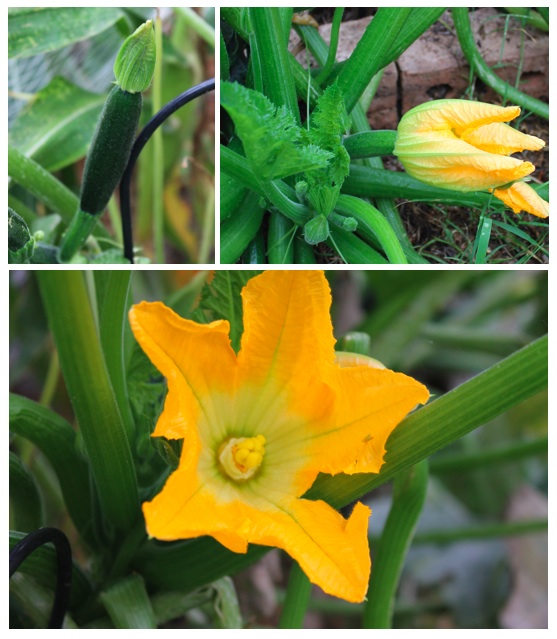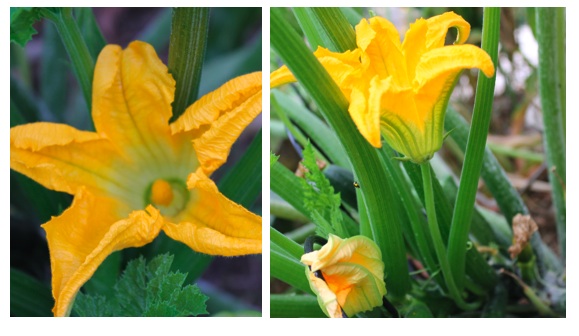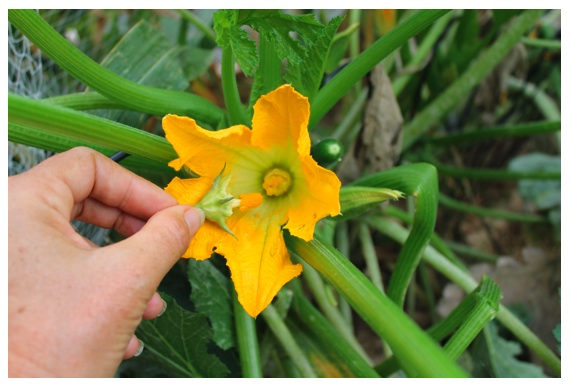 “Why aren’t my zucchinis producing zucchinis?”
“Why aren’t my zucchinis producing zucchinis?”
“My zucchini plant flowers but it doesn’t give me zucchinis to eat”
“My pumpkin has heaps of flowers but no pumpkins”
“Why don’t my zucchinis get any bigger before they go yellow and drop off?”
It’s the same old story year after year, I hear it all the time from keen first-time vegetable gardeners. It’s very frustrating to see the hope of future produce, only to be greatly disappointed when your vegetables don’t grow to maturity.
It’s simply a matter of poor pollination.
Cucumber family plants (aka cucurbits) are renowned for this sort of thing but understanding the plant physiology can help avoid the problem.
Cucurbits include zucchini, courgette, summer and winter squash, pumpkin, melons, cantaloupe and of course cucumbers. These are vines that produce separate male and female flowers. Successful pollination of the male and female flower is imperative for the plant to produce fruit that will grow and mature for you to pick and eat.
Here’s a picture of a FEMALE flower. Notice it has a swollen “receptacle” below the flower that looks like a little zucchini. Inside the flower is the stigma, that receives the pollen from the male flower for successful fertilisation, usually passed on by a visiting bee or other insect.

Here is a MALE flower in comparison. Notice there is no little zucchini below the flower and it has a single straight stamen pointing out from the centre of the flower. The stamen contains all the pollen.

You can hand pollinate your male and female flowers by snapping off a male flower and peel back the petals to reveal the stamen. Then, carefully wipe the stamen on the female stigma to transfer the pollen. Use fresh flowers when they first open in the morning, then the male will have plenty of pollen and the female flower will be most receptive. This always works. The only reason that hand pollination doesn’t work is when the flowers are old: insufficient, or poor quality pollen in the male flower or non receptive female flowers due to age.

You can do the same with your melons, squash or pumpkins.
If your fruit turns yellow and drops off, this is due to ineffective fertilisation. Fertilisation takes place after pollination. It might look like the fruit has swollen and pollination may or may not have taken place. The pollen may have been too weak to properly fertilise the female flower. While it might look like you have some little fruit developing, it doesn’t continue to grow and will soon turn yellow and die.
To encourage natural pollination, you need to attract pollinators into the garden. Do this by planting lots of bee attracting flowers. Make sure you always have lots of flowers, with different shapes, different sizes and different colours all year round. Failing that, take matters into your own hands and manually pollinate for better results. And don’t forget to watch out for other problems you can have with leaf eating ladybirds on your cucurbits.





 Twitter
Twitter Facebook
Facebook
hello everyone I am about to loose my mind!!!!!!!!!!!!! i have been a gardener for about 20 years or so. just a garden in the back yard. this year i swore i was going to get it right do all the right things the perfect soil the perfect plants and seeds not a single weed and SOOOOOO ONNNNN!!!!!
well i just went out as i do everyday i am obsessed with it and IHAVE FLOWERS AND NO FRUIT!!!!!!!! AGAIN MY PEE PODS MY SQUASH WHY WHY WHY i am so upset i cant even tell you hundreds of dollars spent on this garden and again no fruit…. I am so sad PLEASE SOMEONE SEND ME HELP SO I CAN FIX THE PROBLEM
SAD AND CONFUSED
THERESA ;(
Keep up the potassium fertiliser to the plant and micro nutrients to support fruit development.
Don’t let the soil dry out, by don’t over water it either.
Encourage plenty of pollinators by having a range flowers around the garden and try a bit of hand pollinating.
I feel your pain 🙁
I am not sure at all that zucchini need a pollinator to pruduce fruit, unless it is hermaphroditic, because I have one singlel plant in the backyard that I am absolutely sure is the only one in the area.It is producing a lot of fruit .I am having a yellow tip rot issue though.From what I have gathered, this is most likely a calcium deficiency.I am going to give them some calcium, and magnesium and see if it helps.
Zucchini plants produce both male and female flowers on the same plant so only one plant is required for fruit.
You are correct, Blossom End Rot is caused by an underlying calcium deficiency so your solution is right. The condition is highlighted by inconsistent irrigation (possibly through sudden deluges of rain) so be careful to keep your watering regime consistent for best results.
I have plenty of flowers like everyone else, I just went out to look and see the male and female flowers. I see no female flowers at all, what do I do know, I shoul have a ton of zuchini by now??
I’m having the same problem of few female flowers. I check every morn to see if I have female flowers so I can pollinate, and I rarely see the females. I bet my ratio is 6 males to every female. Obviously there were more than I realized because I got mere 4 squash, and probably 6 failures. By this point in the year, I should have at least 4 times this production. I have never had this problem before, of not getting female flowers, except early in the spring, and that is supposedly normal. Maybe the weather is too cool and damp?????
I check in my zucchini flowers every day. All I have gotten is male flowers. Not a single female since they started flowering 6 weeks ago. Can anyone help?
I also have a multitude of male flowers.
Planted marigolds to promote bee attention. But with no female flowers no fruit. What to do? Answers? Please
Often wet weather conditions are prohibitive for female flowers. Just wait and see how the plant goes. There are always many more male flowers than females.
I have plenty of female flowers but no male ones. Why is that? Can anyone suggest a solution?
It’s not too uncommon to see this. Different weather conditions and early stage of plant growth can be the cause. Plants often produce all female flowers and then produce all male flowers. It’s a good idea to have 2 plants so this is not a problem if one plant has female while the other plant has male flowers.
i have only produced 1 courgette fruit this year why
Same and 2 years in a row! Beautiful healthy corgette plants, huge leaves, lots of flowers, no fruit. Grew from seed, very excited to get past the slugs n snails stage intact but this no fruit result is so sad
Yes it’s very disappointing. Try manual pollination like I’ve shown you. I check every morning so that fresh flowers are used. That’s important for success, fresh pollen and early flowers.
I am the same I have heaps of male flowers but no female flowers. I have some ants crawling through mine. <y first time doing this so I feel like I have no idea what I am doing. Are ants a good thing or a bad thing? I need help too please
Weather often has a lot to do with this when conditions are wet and cool.
Male flowers always appear first before the female flowers start coming.
Ants are a sign of dry conditions or impending rain. If your soil is too dry then that will also affect the production rate of female flowers.
I’ve used TUMS as a calcium supplement! Once a week at base-works like a charm
Thank you Veg Lady, very helpful.
Do you crush the tums?
Is it possible to have too many zucchini plants crowd each other out and prevent pollination? I had a bunch come up wild this year and my garden is full. Should I weed some out?
We have a garden again but in the city this time and i am constantly mowing to keep up with the Jones’s so to speak. There are some clover patches in this huge yard but having to mow so much there are just a few bees, and tiny ones at that. Flowers are a great suggestion but i am lost as to what kinds ?
We live in north central missouri. The soil here is a funny color compared to southern Indiana. Kind of a greyish color. Also any suggestions on fertilizer ? I really go for stuff deer dont mess with like cucumbers squash and zukes.
Thanks
Yes I would thin out your zucchini plants to give room for them to thrive. When they’re overcrowded they are prone to fungal diseases.
I think you can’t go past some home made compost for fertiliser.
I’d also suggest that you look at some of the native flora for your region. They have adapted to your conditions and will thrive much better than exotic species. Good luck
Is there any way I can take a picture or snapshot a picture and send it to you? I really need some good planting and growing advice for my cucumber, zucchini squash and tomato plants. I have been bringing them in the house where the temperature is between 70 and 75. It’s been 90 or above here in Baltimore, Md. Unfortunately, my cucumber and zucchini squash plants aren’t doing to well. My zucchini plant is only producing male plants and my cucumber has nice looking leaves and vine but nothing is on them. I planted the last week of May when the frost was done for the winter. My tomato plant has 1 tomato and 2 more coming in. My cherry tomato plant is just a bush…nothing on it. I planted them all at the same time. My only result is one of the tomato plants.
I do have a basil plant and it is growing very well. I have 5 bushes and about 3 more bushes growing in.
FYI: My zucchini, tomatoes and cucumbers are in big flower pots. I rent and my landlord will not allow me to dig up the ground to replant. I also make my own fertilizing liquid plant food. A mixture of banana peels, egg shells and miracle grow plant food sticks. I water them once or twice a week with an exception of rain. I also stay the leaves once a week between watering.
There is a chance for sharing and solving problems as a VIP Club member. More information here:
https://engaging-education.thinkific.com/bundles/vip-club-membership
Everyone is looking for more female flowers and I want only the male!! They are great of you flour, egg and fry them. How can I get ONLY male flowers?? Is this possible??
November 2022 My zucchini plants have only female flowers. It has been a cool, wet Spring. Could this be the cause?
Yes that’s highly likely
Inquirer. Calcium now will not work in the short term. Over the year it might. And its not only first time new gardeners that suffer the pollination problem. It’s the lack o bees and other pollinators.
HELP!! I’m only getting male flowers on my zucchini plants. What’s the issue?
I only have male flowers so I don’t even have the option to manually pollinate. I’m @a loss on what to do at this point. Help????
I have had all of the above problems with courgettes (zuccinis). Particularly a flush of female flowers then a flush of male flowers. but not together.
My thoughts:
Don’t leave it late to sow and plant out courgettes. Get in early spring with an indoor sowing in pots. In my experience late sown plants will tend to produce less fruit.
Extreme weather conditions (especially hot days with cold nights) will affect flowering. You can protect plants with fleece etc on cold nights.
Grow at least three plants to maximise the chances of male and female flowers being open together.
Wouldn’t it be great if we could develop self-pollinating courgettes like we have self-pollinating cucumbers!
Good luck!
What other flowering plants would support the pollinators?
Most flowers will attract pollinators, so just give it a go
Normally I have great success with my veggies. This year raddish and parsnips did not germinate. Carrots are tiny. Zuccini waiting for female flowers. Little cabbages slow to grow. Plenty of rain this year several storms. Used lots of soil improver and compost prior to planting.
Going to use phosphate and general vegie food.
Weather and conditions can be so variable and really affect harvest rates from season to season.
Ok, I have a strange female zucchini issue. I can count nearly 30 developing zucchini on one plant. Is that too many? Is it possible for that many to mature? I have plenty of male flowers too and self pollinate. They are in large pots and in a greenhouse. Should I remove some of them?
Wow, that’s quite a number of flowers. I haven’t seen that many on one plant before so it’s a bit of a first. I’d be inclined to leave them on and see what happens.
The female zucchini flowers are not open yet. Just about 2 or so at a time but since they are yellow zucchini, they are very easy to count how many are coming. I did cut off about 5 already but leaving the rest on. Just not sure if they will mature. I do pollinate with the male flowers by hand. I may have stated that wrong before. I could send you a picture if interested. Hopefully will have them mature!!
Well, just did a count on my yellow zucchini of possible female zucchinis. There are several more than 30 on this one plant. Some of which are super tiny but since they are yellow they are easier to spot. Would share a picture if you are interested. Not sure if I should be cutting some off. Hard pressed to believe they will come to full harvest growth
More than likely they will be a lot smaller. The plant will spread its limited energy into all the flowers and fruit. By removing some of the flowers you could get bigger fruit from those that are left. Fingers crossed. It’s a good science experiment haha
This article is so helpful–thank you!